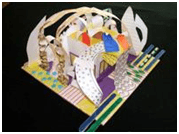Have you ever thought about redesigning your house? World famous architect, Frank Gehry, lived in a California house that was very much like a box. Using his creative genius, he transformed his house into an innovative work of architectural sculpture.
Many people come to see his house. His other designs can be seen around the world – museums, bandshells, and theaters, as well as private residences – all exhibiting his distinctive style.
http://www.greatbuildings.com/buildings/Gehry_house.html
Goal (Terminal Objective):
Students will construct “beyond the box” architectural sculptures of homes or public buildings after learning about the unique style of Frank Gehry. This project will give students a better understanding of architectural concepts for the 21stcentury. It will make them aware of architecture and how the landscape around it is affected.
Objective:
Students will learn about the unique architectural style of Frank Gehry. They will construct models of their original architectural façade sketches, starting with a box form and building beyond with a variety of mixed media materials to create a private home or public art building. They will think about the location of their buildings and how they will enhance the surrounding landscapes.
National Standards:
Visual Arts Grades K4 Content Standard 1: Understanding and applying media, techniques, and processes
Visual Arts Grades K4 Content Standard 2: Using knowledge of structure and functions
Visual Arts Grades K4 Content Standard 3: Choosing and evaluating a range of subject
matter, symbols, and ideas
Visual Arts Grades K4 Content Standard 5: Reflecting upon and assessing the characteristics and merits of their work and the work of others
Visual Arts Grades K4 Content Standard 6: Making connections between visual arts and other disciplines (Geography and Environmental Science Cross Curriculum Connections)
Purpose:
Students will focus on creating 3dimensional art forms. They will view many buildings designed by Frank Gehry and learn paper sculpture techniques, repetition of pattern and design, and mixed media applications.
New Vocabulary:
Frank Gehry, architecture, model, landscape, façade, paper sculpture, public art buildings, embellish, interior, exterior
Materials:

#221403Washable glue sticks

#221101 craftglue

#351436 naturalcraftsticks (not shown)
![]()
#221593 permanentmarkers

#221530 classicmarkers

#221506 metallic markers
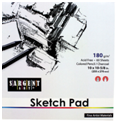
#23-5027 60 Sheet Sketch Pad

#23-5027 60 sheet sketch pad

#22-0914 12 ct. Pointed Tip Student Scissors Best-Pack

#23-40xx 50 ct. Construction Paper
cardboard bases, pencils, sketch paper for thumbnail façade sketches, scissors, construction paper for paper sculpture, construction paper template for box form, paper towels to support insides of boxes, found objects for embellishment
Time:
34 lessons (4560 minutes each)
Introduction and Motivation (Set):
Teacher introduces students to Frank Gehry and architecture as an art form. Students look at several Gehry buildings found in many parts of the world. What is unique about Gehry’s style? Are his buildings large? Are his buildings colorful? How are his buildings used? Does he think about the interiors of his buildings as well as the exteriors? How/why did Gehry develop his style of wavy, swooping shapes? Does his art remind you of the ocean? How is his new building in Panama different from his previous designs?
http://www.biomuseopanama.org/en/building/index.html
http://www.arcspace.com/architects/gehry/panama/index.htm
- Teacher introduces newvocabulary.
- Teacher shows students before and after pictures of Gehry’s home in California. If you were an architect, how would you like to change the exterior of your home? How would the changes affect yourcommunity?
- Teacher shows students a teachercreated“beyond the box” architectural building inspired by the ideas of Frank Gehry. Students brainstorm ideas for their designs that will extend from a basic box form. They make thumbnail sketches of creative facades to be used as references for their threedimensional models


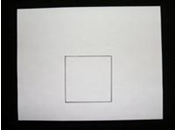
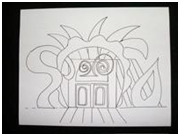
Teachercreated 2D façade template and sketch
Lesson 1:
Teacher presents photos of Frank Gehry buildings to students. Teacher demonstrates cutting and folding the box template and adding windows/doors as desired, either by freehand drawing or cutting/pasting/coloring windows/doors from the teachermade template. Teacher demonstrates pasting the box together, stuffing it with paper towels for added support and attaching it to the cardboard base.










Teachercreated box template and doors/windows templete

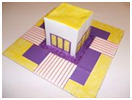
Teachercreated box form attached to base.
Lesson 2:
Teacher demonstrates a variety of paper sculpture ideas (cutting, folding, coiling, twisting, looping, popups, etc.) Students make several paper sculpture shapes. Teacher reviews repetition of patterns and demonstrates adding color to the paper sculpture forms and the basic box. Students colorize as desired. Teacher demonstrates attaching the paper sculpture forms to the basic box and students attach their paper sculpture forms.
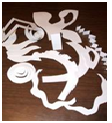
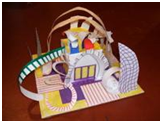
Preparing paper sculpture shapes and attaching them to the basic architectural box
Lesson 3:
Teacher presents students with a variety of mixed-media found objects for desired embellishment. Students select found objects and embellish their buildings.

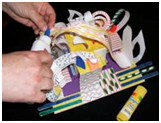
Adding found objects to embellish the architectural sculpture
Activities:
(1) GuidedPractice:
- Students review architecture and 3dimensional art. They are introduced to Frank Gehry and his unique style of architecture. They learn several techniques for paper sculpture. They create original patterns tocolorize.
- Students construct models of innovative houses/buildings fortheir communities.
(2) Independent Practice and Check forUnderstanding:
- Teacher circulates through the room during student work time, answering questions and offering support asneeded.
- Teacher notes students’ understanding of directions and reviews with the class ifnecessary.
(3) Closure
- Students show their completed “beyond the box” architectural models to classmates and discuss how they will enhance the landscape aroundthem. Models are displayed on tables around theroom.
- Students discuss the importance of respect forindividuality.
Evaluation:
Level One – The model conveys knowledge of Frank Gehry’s unique style of architecture. It shows excellent understanding of 3dimensional paper sculpture, repetition of pattern/design and mixed media applications. The completed model is original and detailed. Craftsmanship is excellent.
Level Two – The model conveys good knowledge of Frank Gehry’s unique style of architecture. It shows good understanding of 3dimensional paper sculpture, repetition of pattern/design, and mixed media applications. The completed model is original and detailed. Craftsmanship is good.
Level Three – The student has made an effort to convey some knowledge of Frank Gehry’s unique style of architecture. It shows some understanding of 3dimensional paper sculpture, repetition of pattern/design, and mixed media applications. The completed model is original, but lacks detail. Craftsmanship is fair.
Level Four – The artwork does not convey knowledge Frank Gehry’s unique style of architecture. It shows little understanding of 3dimensional paper sculpture, repetition of pattern/design, and mixed media applications. The artwork is original, but lacks detail. Craftsmanship is poor.
Extension:
Using classroom blocks/legos/small boxes, etc. students will work in small groups to build housing developments where communities of people can work and live without the use of cars.
Resources:
http://www.pritzkerprize.com/gehry.htm#…about%20Frank%20Gehry
http://en.wikipedia.org/wiki/Frank_Gehry
http://architect.architecture.sk/frankowengehryarchitect/frankowengehryarchitect.php
http://www.weisman.umn.edu/exhibits/Frankbio.html
http://www.notablebiographies.com/news/CaGe/GehryFrank.html
http://www.atlanticyards.com/html/ay/gehry.html
http://www.escat.org/~rclarkinia/pdfs/design_principles.pdf
Gehry’s architectural designs
http://whatdoiknow.org/archives/snaps/chicago_gehry.jpg
Chicago
http://www.flickr.com/photos/antsolar/505352344/
Iowa City
http://www.bluffton.edu/~sullivanm/gehryca/norton.html
Norton house, Venice
http://www.businessinnovationinsider.com/archives/Guggenheim%20Bilbao%202thumb.jpg
Guggenheim Museum, Bilbao, Spain
Art Consultant



